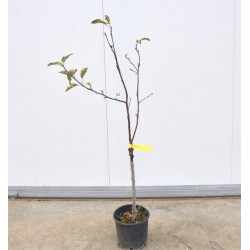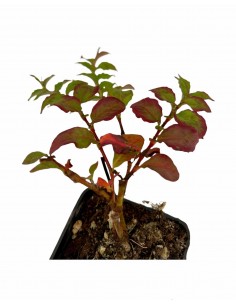Golden Delicius Apple Tree
Generalities :
The Golden Delicius apple is a widespread apple variety of great value and widely cultivated. The tree is vigorous and very productive, the fruit is of medium size with a golden yellow skin when fully ripe. The cream-colored pulp is compact and crunchy, juicy, slightly acidic, very aromatic, with a good sugar content and acidity. Ripens from October to December. The exposure of the apple tree can be in full sun, however it must be a place not subject to strong gusts of wind.
- jar 16cm, height 120/150cm
- jar 22cm, height 150/170cm
Generalities:
the Golden Delicius apple is a fruit of excellent size, with an average weight of 170-190 grams, elongated truncated-conical shape, yellow in color near the harvest, very suitable for long storage. The shape of the fruit is particularly influenced by the hilly cultivation environment, which favors the natural formation of giberelline, which determine a significant elongation of the vertical axis, also making the calicine fossa more ribbed on average. The epidermis is smooth or slightly rusty, green to yellow, with clear and well distributed lenticels. In the presence of temperature drops and high relative humidity in the period prior to maturation, it tends to take on a pink over-coloring. The cream-colored pulp is compact and crunchy, juicy, slightly acidic, very aromatic, with a good sugar content and acidity.
Cultivation and Care :
For the cultivation of apples, the most favorable territories for growth and production are the hilly and mountain ones. The soil must be rich in organic matter, not excessively calcareous and well drained. The temperature in most cases is not a problem, the apple tree in fact manages to withstand well even at particularly low temperatures. The exposure of the apple tree can be in full sun, however it must be a place not subject to strong gusts of wind. The small-bearing varieties can be planted at a distance of 1.5-2 meters from each other, the rows should be spaced from 3 to 3.5 meters. The plants can be equipped with braces for the first years of their growth, then it will be possible to remove the support and let the plant grow freely, which at that point will have reached a correct position. The fertilization will be done at the time of planting, for each hole 2-3 kg of mature manure will be inserted. In the following spring, about 100 g of ammonium sulphate will have to be integrated for each plant. Every year at the end of the winter period a predominantly nitrogen fertilization should be administered, approximately 60 g of ammonium sulphate for each square meter of cultivation, every two years it is also advisable to carry out a fertilization of phosphorus and potassium, to be distributed slightly moving the soil on the surface and trying to distribute it evenly as much as possible.























